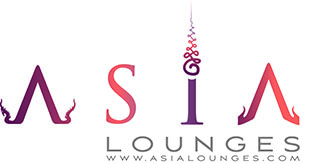Hey Loungers,
Today we have the pleasure of concluding the Microteers Arc by interviewing the Light Bender and third Microteer: GIA’s Nathan Renfro!
Nathan is a talented and outspoken gemmologist, excellent photographer of course, one of the three legendary Microteers and disciple of the Titan: John Koivula himself!
Today we have the opportunity to learn more about Nathan with this interview!
Nathan, the floor is yours!
AsiaLounges: First of all thank you very much for agreeing to being with us today Nathan. Can you tell us more about yourself? Who are you Nathan Renfro?
Nathan Renfro: Well, I am a professional gemologist and currently the Manager of the Colored Stones department for GIA in Carlsbad and New York. I am originally from western North Carolina where I went to school for geology, a career that was ignited by my grandfather’s interest in rocks and minerals. In 2006 I moved to southern California to pursue studies in gemology at GIA in Carlsbad California, and then I just never left. I began working for GIA in 2007 and established roots in the area where I live with my wife, two children, a cat, a dog and as my Instagram followers know, more tortoises than any reasonable person should have.
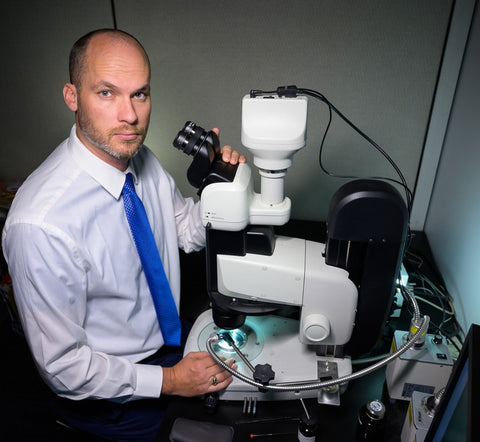
Nathan Renfro working with a Nikon SMZ25 microscope system. Photo by Kevin Schumacher, copyright/GIA
AsiaLounges: Further to the first question, we’d like to know how you got into the gem trade and, by extension, how did you become a photomicrographer and one of the famed Microteers?
Nathan Renfro: Well, as I mentioned, I have a background in geology. While working on my geology degree I needed a summer job that would complement my studies and I got a job at a local tourist gem mine attraction close to my hometown. That place was called Emerald Village after its close proximity to the Crabtree Emerald Mine in Little Switzerland, North Carolina. Well, early in the tourist season, we would often have a few hours a day with no customers and I would use that time to play around on the lapidary equipment. Eventually I became reasonably proficient at cutting gems and it became a pretty serious hobby. I even took out a small loan from my mom at the age of 18 to buy my own cab machine (which I still use, by the way).
Anyway, one day I was reading a copy of Lapidary Journal and saw an advertisement for GIA about their gemology program. Up until that time, I didn’t really realize that gemology was a career path, but when I saw that ad, I immediately knew that this was the direction I would be heading towards.
After finishing my geology degree, I moved to California to attend GIA’s GG program in Carlsbad having received The William Goldberg Diamond scholarship. After finishing the program, I applied for a diamond grading job at GIA so I could enjoy the California sun a bit longer as I was not looking forward to a cold winter back home. I got the job as a diamond grader, but quickly had my sights set on the Colored Stone or Gem Identification department as it was known at the time.
After six months of grading diamonds, I had the good fortune of a position opening up in Colored Stones, so I applied and ultimately transferred from diamond grading to Colored Stones in July 2008. That is how I entered the gem trade. How I got interested in photomicrography is a continuation of that story…While in my new position as a staff gemologist in the Colored Stone department, I had the good fortune to work with some of the world’s most knowledgeable and experienced gemologists including Dino DeGhionno, who was my Manager and Shane McClure who was the department Director. Finally, there was John Koivula who at the time had recently returned to GIA as Chief Gemologist. John and I came from similar backgrounds and shared a lot of common interests and we became fast friends. He showed me the ropes of photomicrography and properly introduced me to the fascinating world of inclusions and I was quickly addicted, spending much of my time outside of work with my eyes buried in a microscope looking for strange things in gems.
AsiaLounges: Those of us that have been following your work have heard that you are the student of legendary inclusion photographer John Koivula. Is this a boon or does that put that much more pressure on your shoulder to excel in your art? Why?
Nathan Renfro: Well, it is true that I owe much of my success to having John’s guidance and support. For me, I’ve never really felt any pressure just because I happened to have learned from John. I feel like I got to take a shortcut by being able to learn directly from the undisputed master of photomicrography as he was always ready to offer advice on how to shoot a stone or answer any questions I had. At the same time, he also would always let me find my own way too. I think this was important as I had to learn how to problem solve difficult stones myself, but I always knew that if I got really stuck on a how to shoot a stone, I could just walk to the room next door and ask him for help. John has always been such a big supporter that I don’t think that I have ever felt any “pressure” to excel as strange as it may seem. I think my success comes from having a good support system in John which accelerated my skillset, but also I have an intrinsic love of the microscope and inclusions which really contributed to my success as well.
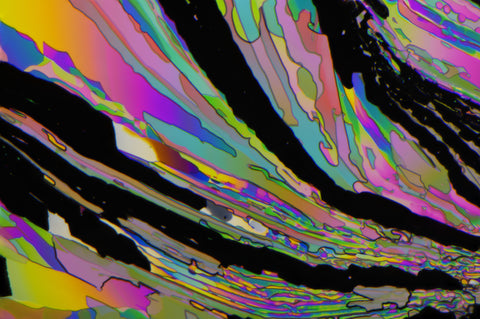
This Topaz has a partially healed cleavage crack that shows vibrant interference colors using oblique fiber optic illumination. Field of View 2.87mm. Photo copyright/GIA
AsiaLounges: Your pictures differ a lot from your fellow Microteer in that that you make extensive use of differential interference contrast and the false color technique known as Rheinberg Illumination. Why did you make that choice? What are the advantages and inconvenience of such techniques compared to what your fellow Microteers are using?
Nathan Renfro: You are right, I think my “style” is quite a bit different from my fellow Microteers. Billie has a super dramatic, beautiful style where she plays with high contrast and incorporates lots of interesting shadowed areas. Danny has an otherworldly, dark but colorful style that tricks your brain into thinking you are in the middle of some alien landscape. I think my style is generally characterized by excessive use of vibrant colors and geometric patterns. For me, that’s the “look” that appeals most to me. Differential interference contrast is a technique that John introduced me to many years ago in addition to Rheinberg illumination, which lets you apply high color contrast to low contrast surfaces just by controlling light with specialized hardware in the case of DIC, or colored filters in the case of Rheinberg illumination. I immediately knew these were techniques that I wanted to explore further and I even built my own DIC microscope system from vintage parts on the used market. In short, I think I’m just drawn to the crazy color possibilities that you can get with these specialized microscopy techniques, so I incorporate them into my work quite heavily in addition to standard light microscopy.
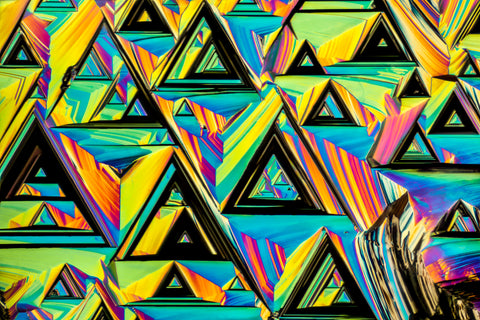
I think this photo is a good summary of my “style” showcasing excessive use of color and geometric patterns. This is the surface of a diamond from Greenland using Differential Interference Contrast. Field of View: 1.4mm. Stone Courtesy of the John Koivula Inclusion Collection
AsiaLounges: Further to the last question, almost all the photographers we had the pleasure of interviewing here, for A Gem Dealer’s Journal, mentioned the importance of light. Danny, whom we interviewed recently went so far as to say that one should always double up the amount of light sources that one believes he’ll need for a shot. What is your take on the importance of light and, what is, for you, the most important tool for a photographer such as yourself? Why?
Nathan Renfro: Light is definitely super important and I often find myself wanting more light even though I have 4 fiber optic light sources on hand. Shooting gems properly often requires you to do things that decrease the amount of light that the camera receives such as using a polarizing filter or simply increasing the magnification. So, Danny is certainly on the right track about doubling the amount of light you think you will need.
I think the most important thing for me is controlling the light. My style also tends to be more diffused and I shoot most stones inside of a little white film canisters that I have modified to evenly distribute or diffuse the light out across the whole stone. I think for me, the diffusers are the most important tool that I use.

This prase opal from Tanzania resembles an aerial view of a coastline. Field of View 9.70mm - Photo Credits: Nathan Renfro
AsiaLounges: With today’s multiplication of inclusion photographers online, either on Facebook, Instagram or other media. I’d like to ask you what makes, in your opinion, the difference between a good and a bad photomicrograph?
Nathan Renfro: I think from a technical aspect, it is lighting control. If you just put the stone in the microscope well, and click the shutter, your photo might look like the stone, but there is a good chance that the lighting is going to be very uneven. It’s not hard to imagine that faceted stones are light are basically a series of tiny mirrors all at different angles and orientations. Some arrangements of the mirrors, or facets, might work well with the generic darkfield lighting from a gemological microscope and some areas or facets may not play so nice with the same lighting. So, you really have to look at the stone and control the light for individual areas in the stone rather than apply a lighting environment broadly to a stone and hoping for the best.

Modified Rheinberg illumination was used to provide high contrast in vibrant colors to the surface features of this synthetic rock crystal quartz. Field of view: 5.46mm - Photo Credit: Nathan Renfro
AsiaLounges: Further to the last question, being yourself one of the best photomicrographers worldwide, I’d like to ask you, how does one reach your level? Is it, as it is sometimes heard, exclusively due to the difference of material or, as we believe it here at AsiaLounges, a question of affinity and practice?
Nathan Renfro: That’s a pretty easy answer in my experience, I think my success results from a love of doing what I do and countless hours of practice. When I started out, I would spend 3-4 hours a day buried in the microscope after being at work all day being buried in the microscope. For me, it was like I was addicted and I couldn’t stop. Once I incorporated a camera, it look a lot of practice to get the photos to look like the scenes I was seeing in the microscope. I took a lot, and I can’t overstate this enough….a LOT of really terrible photos for a long time, but gradually they got better and increased in their frequency. Now, I have enough experience to quickly light a stone the way I want and take the photo. Most of my photos now don’t take very long to shoot (unless it’s some special experimental project I’m working on of course), but I think I have become very efficient at getting the photo I want out of my photomicroscope. So in short, the result is from a love of photomicrography and an extreme amount of practice.
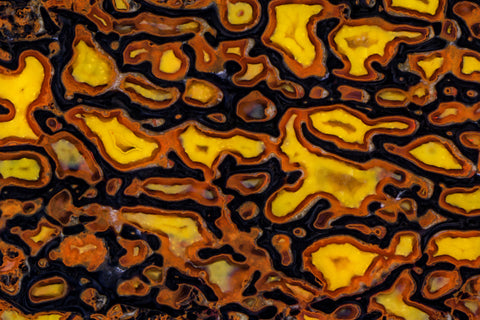
This photomicrograph of fossil dinosaur gem bone is composed of several images stitched together in a mosaic to produce a high resolution image. Experimental images like this or those that are stacked generally take longer to produce a good result than images composed of a single frame. Field of View: 14.04mm Photo copyright/GIA
AsiaLounges: Do you believe that it is necessary in today’s world to be a gemologist if you want to be a proficient photomicrographer? Why?
Nathan Renfro: Well, I don’t think it’s exactly necessary, but it’s certainly helpful. I think that it seems consumers of gems want to know more about the stones they are purchasing. I think being able to show consumers what makes their stone unique can be a viewed as an enhancement and not a detraction to their stone. Inclusions can be used to fingerprint or identify a stone as unique and I think in today’s world where everyone has a pretty good camera in their pocket, that a lot of people have the ability to take pretty good photomicrographs. That being said, I don’t think its particularly necessary for most, with exceptions being researchers who need to publish photomicrographs in order to illustrate features of gems for their work, like what you will find in the journal Gems & Gemology.

Colored filters were used to bring out contrast in this rock crystal quartz that contains a multitude of three-phase fluid inclusions using a technique known as “modified Rheinberg illumination”. Field of View: 4.65mm Photo copyright/GIA
AsiaLounges: We have been enjoying teasing our interviewees recently with questions on ethics in the gem trade / gem world. What does it mean to you, as a lab gemologist, as a photomicrographer and a researcher for the GIA?
Nathan Renfro: I think the gem trade as a whole is generally pretty ethical. While I have occasionally seen unethical practices by individual people who intentionally do not disclose treatments in order to defraud the public, such as dyeing opal interesting colors and claiming it to be natural, there are many trade organizations that champion ethical practices throughout the industry. GIA’s mission is to ensure the public trust in gems and jewelry through research, education and labservices. As a lab gemologist I have been involved with providing the public with information about our research to inform them of new treatments and how to recognize them so that they don’t fall victim to unethical trade practices, like undisclosed treatments.

The surface etching on this colorless beryl resembles a heart. Differential interference contrast microscopy shows the details of the etching in vibrantly colored, high contrast. Field of View: 1.1mm - Photo Credits: Nathan Renfro
AsiaLounges: Last but not least, we would like to ask you to provide three advices to people that would like to follow in your footsteps and three books that you believe are required of any gem geek to have in their library?
Nathan Renfro: Three pieces of advice for those wanting to be photomicrographers…let’s see…
1. I think it is better to get a higher quality used microscope than a lower quality new one. It is possible to get a research grade microscope for pennies on the dollar in the second hand market. Even thought they might be old, research grade instruments in my experience were built to last. My two main personal microscopes I use were built around 1960 and 1984 and still work as well today as they day they were produced.
2. Practice, practice practice…I still can’t overstate how much time I spent taking really bad photos. While the results I achieved in my photos weren’t very good in the beginning, the thing of value that I was getting was experience and that has proven to be very useful over the years.
3. Learn how to cut gemstones. I started cutting gems when I was 18 and while I don’t really cut stones for the purpose of producing a finished gem these days, I regularly cut windows or re-polish surfaces of stones in order to take a better photo or look into a stone from a different orientation. It also allows me to buy rough samples with inclusions and polish a window for a fraction of the price that I can buy a finished gem. Since I typically am interested primarily in the inclusion, it has allowed my inclusion collection to grow more than if I only relied on finished gems.
Three books that anyone should have in their library….first and foremost is the Photoatlas of Inclusions in Gemstones series by Gübelin and Koivula (its 3 books, but I’ll count it at 1). Another book in the library of any true gem geek is Ruby & Sapphire: A Gemologist's Guide by Richard Hughes, with Wimon Manorotkul and E. Billie Hughes. This is the most comprehensive work on a single gem material that I’ve ever seen, which is particularly good if you like corundum gems. The other one that I am really very fond of is The Microworld of Diamonds by John Koivula. This book is filled with photomicrographs and information all related to diamonds….and my wife’s engagement ring diamond is in that book which John gave me, so maybe I’m a bit biased. Even if I wasn’t biased, it’s still a really great book that any gem geek should own.
AsiaLounges: Thank you very much Nathan for being with us today, I am convinced that our readers, the Loungers, have enjoyed this interview as much as we did enjoy writing these lines.
As for us, we will meet you again soon in the Lounges with more exciting content! If you have enjoyed this interview please let us know by liking, commenting and sharing our work with your family and friends on your favourite social media platform. Don't forget that you can also support A Gem Dealer's Journal through our Patreon's Page. It helps us a lot and takes but a second!
Should you have any questions or topic that you’d like us to research for a future interviews and articles, feel free to let us know by contacting us at simon@asialounges.com, it is always a pleasure to dig further into the world of gems and gemmology!
For all the rest, feel free to take a look at our gem and jewellery collection as well as to contact us should you be interested in getting one of our famed bespoke pieces of AsiaLounges Jewellery.
See you again in the Lounges,
